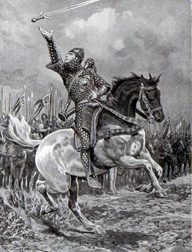 Stirrups. We take them for granted. But 1,000 years ago they brought about an important change in mounted warfare. Many historians even credit them for the Norman Conquest of England in 1066.
Stirrups. We take them for granted. But 1,000 years ago they brought about an important change in mounted warfare. Many historians even credit them for the Norman Conquest of England in 1066.
Ancient Western cavalrymen – Assyrian, Persian and Greek – essentially rode bareback (without framed saddles) while wielding their shields and lances. The solid frame saddle developed by Romans to give their cavalrymen greater security, also enabled them to fight more effectively.
But when stirrups were attached to a saddle, the energy of a running horse could be transferred to the weapon being held by its rider – as Harold’s foot soldiers found out as they struggled against the stirrup-equipped Norman cavalry at the Battle of Hastings.
I was inspired to research this topic a few days ago, after I watched an early episode of science historian James Burke’s landmark PBS Series “Connections.” The episode begins with a nuclear bomb in a briefcase, jumps back to the Battle of Hastings and the stirrup, which triggers a series of connections from the longbow to the plow to crop rotation to gun powder to water wheels to metal mines to barometers to electro-magnetism to inter-stellar communication.
Click here to watch the episode and settle in for a wild ride. If you’ve never watched “Connections,” you’re in for a treat.
